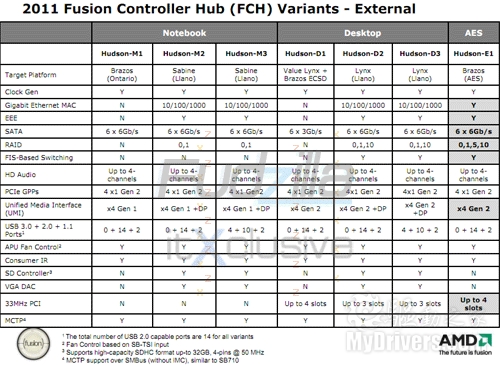 AMD Fusion APU processors have appeared frequently, but the supporting platform chipset is quite low-key, until today we were informed of its complete model, specifications table.
AMD Fusion APU processors have appeared frequently, but the supporting platform chipset is quite low-key, until today we were informed of its complete model, specifications table.
The first batch of AMD APU processors is divided into two major parts, among which the ultra-low-power platform Brazos includes two sub-series Zacate E series and Ontario C series, which will be released early next year. The high-performance platforms Sabine and Lynx are for mobile and desktop applications, respectively. 32nm Llano, introduced mid-year next year.
Because the AMD APU integrates graphics cores, memory controllers, and UVD decoding engines, the companion chipset "Hudson" is simplified as a single-chip design. It is called the "Fusion Controller Hub" (Fusion Controller Center) and is abbreviated as FCH. There are seven different versions for three market segments.
The seven versions of the Hudson PCH have the same features, such as a clock generator, up to four channels of HD Audio audio controller, four PCI-E 2.0 x1 GPP channels, APU fan control (based on SB-TSI input), consumer level Infrared, MCTP management component transfer protocol (similar to SB710 via SMBus bus support).
There are three versions of the Hudson-M3, Hudson-M2, and Hudson-M1 for notebooks. The specifications are successively reduced. The first two Llano APU processors correspond to the platform Sabine, and the last one is the Ontario processor and Brazos platform.
Hudson-M3 integrates Gigabit Ethernet MCA and supports Energy Efficient Ethernet (EEE), supports RAID 0/1 disk array mode, bus interface is PCI-E 1.0 x4+DP UMI, provides four USB 3.0, ten USB 2.0, Two USB 1.1 interfaces, six SATA 6Gbps interfaces, SD controller (supports SDHC memory cards up to 32GB), VGA DAC, but no longer natively supports the PCI bus as the Intel 6 series.
The Hudson-M2 is basically similar, except that the USB 3.0 interface has been cut off and replaced with fourteen USB 2.0.
The Hudson-M1 has a very large deletion, removing Gigabit Ethernet MAC, EEE technology, RAID 0/1, DP UMI bus, SD controller, VGA DAC (that is, does not support VGA output interface), but the chip has taken the lead Shipments are basically used in the first batch of APU platform products.
There are also three versions of Hudson-D3, Hudson-D2, and Hudson-D1 for the desktop. The specifications are getting lower and lower. The first two models are equipped with the Llano APU processor, the corresponding platform is Lynx, and the last one is the hybrid cheap Lynx. Platform and the so-called Brazos ECSD platform.
The Hudson-D3 specification is the most complete of the family. It also adds a RAID 10 disk array, FIS-based switching technology, PCI-E 2.0 x4+DP UMI bus, and up to three PCI bus channels compared to the Hudson-M3. It is also natively supported. Four USB 3.0 interfaces.
Hudson-D2, like its mobile version, also removes native USB 3.0.
The Hudson-D1 is also similar to the mobile version, but the disk interface is degraded to six SATA 3Gbps, PCI lanes are increased to four, and the PCI-E x4 UMI bus retains second-generation standards.
The last is the more special Hudson-E1, for the so-called AES applications, used on the Brazos AES platform. The specification adds another RAID 5 disk array mode, and there are also four PCI channels, but no native USB 3.0, no SD controller and no VGA DAC There is also no DP UMI bus.
The specification of this chip has not been finalized yet, and the release date will be the latest. It may take until the second half of next year.